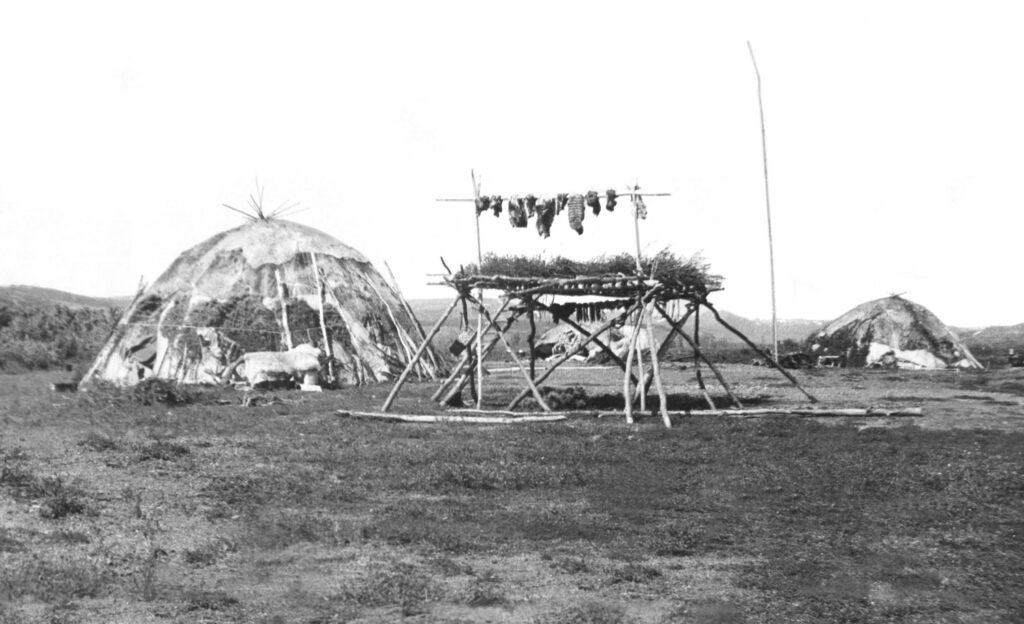
Handicrafts developed on the basis of marine animal hunting and reindeer herding: the manufacture of rovduga (suede), the manufacture of kitchen jackets, blankets, carpets, corn, gloves, mittens, and torbaz for sale. From the fat-soaked seal skin, thanks to which it was made waterproof, suitcases were made for sale to the Russians, and a torbaza in the form of boots was sewn for sale to Alaska.
“"In addition to boots, needlewomen prepare during the long winter many rugs of various sizes from white and multi-colored sealskin, carved with various figures, with an edge of some kind of fur, embroidered handbags, belts, gun cases, cartridge belts and other trifles. Men cut from bone unpretentious chains, paper knives, mouthpieces, pipes, buttons, models of steamers and schooners, polish beautiful walrus tusks. Some achieve great elegance in their work, acquire lathes in America especially for this purpose "” (Калинников, 1912. С. 123-124).
Handicraft production serving the foreign market emerged only on the eastern coast of Chukotka. To a greater extent, women were involved. Buyers of handicrafts, in accordance with the market demand, ordered items from samples that deviated from traditional forms, often completely new items made from local materials (Ivanov 1949, pp. 107-124).
With the development of whaling in the Bering Sea, the captains of whaling schooners preferred to hire Chukchi and Eskimo sailors on their ships. They were cheap labor, easily able to bear the rigors of life on a small boat. At the end of the voyage, such an employee was paid with a rifle, a box of tobacco and crackers.
The most common hunting tools for land animals were the bow and arrow and the spear. Most of the hunting tools for marine mammals were harpoons of various sizes with detachable tips.
The materials for the manufacture of tools were wood, bone, whalebone and iron. In the XVII and XVIII centuries. stone (obsidian, flint, slate) was widely used, from which they made inserts for harpoons, spearheads, arrows. Bow and arrows, shafts for harpoons, spears, darts, spear throwers were made of wood. The most widely used were the bones and antlers of deer, walrus tusks, whale ribs and jaws. Deer horns were used to make arrowheads, punctures, parts of harness, spears for sledges, snow shooters (from clothes and canopy), spoons, and hooks for hanging. Deer ribs were used to make knives, plates for shells, etc. Whalebone was used as a material for arrowhead inserts. They attached the wooden base of the bows. From the fibers of the whalebone they made fishing line, weaved nets, nets.
In the 18th century, gatte stone axes, spearheads and arrowheads, and bone knives were almost replaced by metal ones. By the middle of the XIX century, iron, copper firmly entered the use of the Chukchi, became an irreplaceable material for tools and weapons. Metal knives, spearheads, cauldrons, and needles were bought as finished products. The Chukchi often made arrowheads and armor themselves from copper and iron cauldrons.
The main armament of the Chukchi warrior consisted of a bow with arrows and a spear. As can be understood from T.I. Shmalev, the Chukchi's bows were complex, consisted of several glued layers. A whalebone was used to strengthen the bow. The feathers of the arrows were the feathers of geese, ravens, gulls and owls. Unlike the Koryaks and Yukaghirs, the Chukchi attached not three feathers to the arrow, but two. It is known that the Chukchi often exchanged bows and materials for them from the Koryaks and Alaskan Eskimos.
From the means of protection of a warrior in the XVII-XVIII centuries two types of shells were used. A shell made of walrus skin or whalebone was obviously developed by sea animal hunters (Eskimos); a shell made of bone or metal plates is also known from other peoples of Asia. There were also iron chain mail made of elongated pieces of iron fastened with straps, as well as the same helmets with a visor and headphones.
Наконечники стрел чукчи мазали ядовитым соком лютика. В качестве оружия применяли также “каменные шибалки” – пращи, а также арканы.
Описанное вооружение существовало до конца XVIII в., хотя уже тогда, не¬смотря на строгие запреты продажи чукчам металлических изделий, металлическое оружие к ним все же проникало. В 1778 г. Д. Кук видел у них “cook saw them with "iron or steel spears of European design, which they carried on a leather belt over their right shoulder"” (Кук, 1971. С. 101). Описывая вооружение чукчей в первой четверти XIX в., капитан Шишмарев особенно выделял ножи: “Главнейшее их оружие, в аршин длиною нож, всегда носимый при себе и сохраняемый в чехле, у некоторых еще по одному или по два меньших ножа, обыкновенно спрятанных в кармане или за рукавом” (Сведения э чукчах, 1852. С. 183).
At the end of the XVIII century. military clashes between the Chukchi and their neighbors ceased, shells, bows, spears, combat arrows became the subject of relic character.
Corporal G. Sheikin, служивший в Анадырском остроге в 50-х годах XVIII в., так описывает панцири и стрелы чукчей: “Чукчи ж место панциря во время баталии надевают куяки однобоки, деланы из железа и из китовых усов, и на голову от куяка открылок – доска деревянная и обитая кожей морской, лафтаком называется, из-за которой доски, выглядывая, стреляют из деревянного лука стрелою, которая подобна татарским стрелам… копье вставлено костяное и то присажено не крепко, она же с зазуброй, дабы есть ли потрафит в человека, то стрела выдернетца, а копье останетца в человечьей ране. Перья ж к стрелам не приклеивают, а привязывают жилками только по концам” (Цит. по: История и культура чукчей, 1987. С. 72).
Vdovin I. S., Batyanova E.P.
(from the book “Peoples of the North-East of Siberia”)




